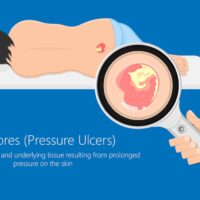SOUNDING THE ALARM ABOUT BEDSORES IN NURSING HOME PATIENTS

“Bedsores — also called pressure ulcers — are injuries to skin and underlying tissue resulting from prolonged pressure on the skin,”
the Mayo Clinic explains. “People most at risk of bedsores are those with a medical condition that limits their ability to change positions or those who spend most of their time in a bed or chair.” Elderly patients in nursing homes certainly fit that description, and in fact, bedsores represent a very widespread problem in many facilities nationwide.
The three primary factors involved in the development of bed sores, Mayo Clinic writers continue, are:
- Pressure. Constant pressure on any part of your body can lessen the blood flow to tissues, depriving the skin and nearby tissue of oxygen and other nutrients.
- Friction. Friction occurs when the skin rubs against clothing or bedding. It can make fragile skin more vulnerable to injury, especially if the skin is also moist.
- Shear. Shear occurs when two surfaces move in the opposite direction. For example, when a bed is elevated and the body slides down, the skin over the bone might stay in place, pulling in the opposite direction.
Elderly patients in nursing homes are at particular risk for developing pressure sores; often they have difficulty moving and are unable to easily change position while seated or in bed. Health problems such as diabetes and vascular disease increase the risk of tissue damage.
The development of bedsores in nursing home patients is almost certainly cause for alarm and further scrutiny, cautions the Nursing Home Abuse Guide.org. If left untreated, the complications from bedsores can include:, gangrene, sepsis, bone and joint infection, amputation and even cancer of lymph nodes or skin cells.
Because of these risks associated with bedsores, it’s important to make sure a family member is not being neglected or mistreated while in a nursing home or other healthcare facility. Staff and nursing home facilities are required to provide a certain level of care for all their patients or residents, including the prevention of bedsores.
In a nursing home facility, neglect might be happening if staff members do not reposition disabled patients regularly. At Ramey & Hailey, we believe that when negligence, neglect, or abuse happens in a facility, it is important to file a medical malpractice lawsuit. Not only is a civil lawsuit the only avenue for recovering financial damages (to help pay for remedial medical care or the costs of changing facilities), but if harm has befallen your family member, that means it has probably been happening to other patients as well.
Abuse in nursing homes is against the law!




